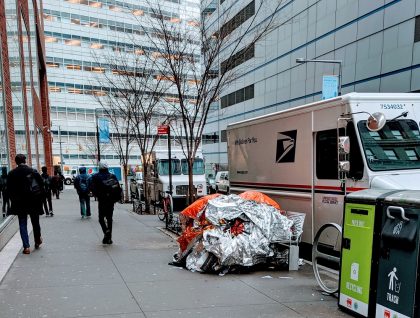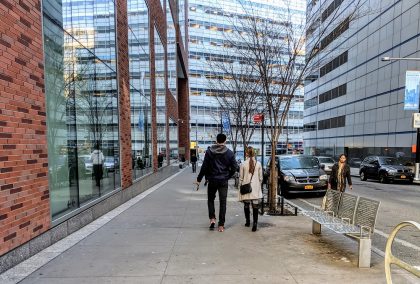Homeless encampment on Park Place near BMCC is cleared
I had a couple of complaints about an encampment on Park Place and West Broadway on a bench just outside BMCC’s Fiterman Hall. Clearly this was a real problem, and not the least because that block serves thousands of college students each day. I sent an email to the communication’s staff of the Department of Social Services on Feb. 26; yesterday I got this response and walked down to see that indeed, the bench is cleared. If you read on, there’s a very thorough explanation of how DHS/DSS handles complaints about the homeless. For example, I did not know that we had outreach workers visiting the area every day.
I also did not know that the city cannot force anyone off the street unless they are a danger to others. The loitering law only applies to people possessing a controlled substance or gambling. You also can’t loiter near a school. From DSS:
“We do not tolerate encampments in our City. While the conditions here were not an encampment, the location has been cleared and we will continue to focus on this area to make sure that these unacceptable conditions do not regenerate. Our outreach teams canvass this area at least once daily, engaging individuals who may be homeless and encouraging them to accept services. Since the launch of HOME-STAT, the most comprehensive street homeless outreach program nationwide, outreach teams have helped more than 2,450 homeless New Yorkers off the streets citywide, thanks to new investments and tripling the number of outreach workers, and we remain undeterred in our efforts to engage clients proactively until we make the connection that will help them transition off the streets.”]
DSS also sent the following information on its outreach in this specific area of Manhattan:
- Teams canvass this location at least once daily, five days a week, and continue to actively engage three verified homeless individuals encountered on the streets in this area in an effort to offer them services and help them come indoors. Those individuals are known to the teams by name and we continue to work closely with them to encourage them to accept services and transition off the streets.
- For another three individuals encountered on the streets in this area, teams have not yet ascertained enough information to verify if they are homeless, but continue to engage them in order to assess their living situation and determine what services they may need.
- Through persistent outreach, HOME-STAT teams from the Manhattan Outreach Consortium have made two recent placement from this area to transitional or permanent housing opportunities.
New Yorkers sleeping on the streets are our most uniquely challenging population to engage. With higher rates of mental health and substance use disorders, medical difficulties and disabilities, and with each individual finding his or her way to the street via different paths, it can take time to bring these individuals indoors from unsheltered environments (several months on average) and involves hundreds of contacts with outreach teams to build the trust and relationship that will result in ultimately accepting services. Facing complex, layered challenges, unsheltered individuals may be resistant to accepting services. And accepting outreach efforts is voluntary. In accordance with NYS Mental Hygiene Law, street homeless New Yorkers cannot be involuntarily removed from the streets unless they are posing a danger to themselves or others.
All street homeless outreach teams have access to:
- licensed clinicians who work with clients on the streets, provide ongoing case management, and assess each individual for immediate risk/crisis during each encounter
- psychiatrists who perform psychiatric evaluations on the streets, as needed, helping understand and better meet the individual needs of each street homeless New Yorker
- substance use resources, including ability to immediately connect individuals to detox and other rehabilitation programs—and are trained in naloxone administration
The city has tripled the number of outreach staff since 2014 from fewer than 200 to nearly 600 and quadrupled the number of emergency ‘safe haven’ and ‘stabilization’ beds dedicated to serving the street homeless, from 600 to more than 1,800. The addition of 1,000 new beds in the next two years will increase the citywide total by 65 percent, to approximately 2,800 beds. The city is also building a by-name list of individuals known to be homeless and residing on the streets.













Do you know what happened to that homeless person? Where did s/he go?
There was another homeless person at the corner of Duane and Greenwich Streets. She had been around the neighborhood for quite some time because I used to see her at the corner of Reade and Greenwich and at the Washington Market Park. Earlier this winter (when we had a bit of cold spell), I became concerned about her and called 311. Apparently, we have two options: 1. have the police come to make them move or 2. have the homeless outreach come to check up on them. I chose the option 2. The ambulance came and they told me she was sleeping. A week or so after that, she wasn’t at that spot anymore. I don’t know where she went or if someone ‘moved’ her. Hope she’s ok.
See the comments on this post.
I remember while Serafina was under construction, the homeless woman with the easy bake oven under the scaffolding. She had a studio apartment under that scaffold.
Who is responsible for power washing that bench area? I walked by iit the other day and the layer of filth is disturbing. The bench is not useable again until it is cleaned.